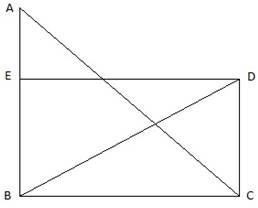The angle of elevation of the top of a chimney from the foot of a tower is 60° and the angle of depression of the foot of the chimney from the top of the tower is 30°. If the height of the tower is 40 metres, find the height of the chimney.
According to pollution control norms, the minimum height of a smoke-emitting chimney should be 100 metres. State if the height of the above-mentioned chimney meets the pollution norms. What value is discussed in this question?

Let AB be the chimney and DC be the tower. We are given that the angle of elevation of the top of the chimney from the foot of the tower DC is 60°. Join A and C. We get a right-angled ∆ABC with right angle at B and ∠ACB = 60°. We are again told that the angle of depression of the foot of the chimney from the top of the tower is 30°. If we join B and D, then we get a right-angled ∆BCD with right angle at C. Draw a line from D to a point on AB parallel to BC. So, ∠EDB = 30° and ∠DBC = 30°. The height of the tower is given to be 40 m. So, DC = 40m. We will first find the height of the chimney AB. If AB is less then 100 m, then it does not meet the pollution norms and if otherwise, then it does not meet the pollution norms.
First, we will find the value of BC from ∆BCD using the trigonometric ratio tan. Then using the value of BC, we will find the value of AB from ∆ABC using the trigonometric ratio tan.
In ∆BDC,
![]()
or,
![]()
In ∆ABC,
![]()
or,
![]()
So, the height of the chimney is AB = 120m, which is greater than 100 m.
The height satisfies the pollution norms.